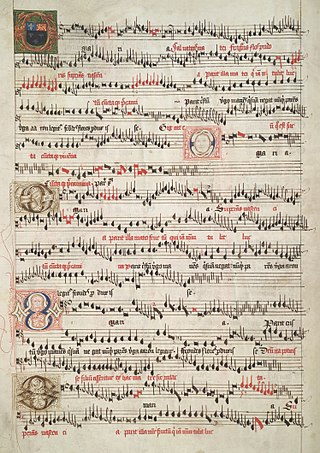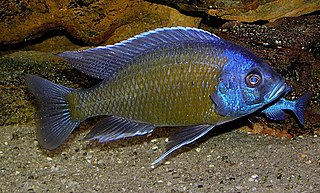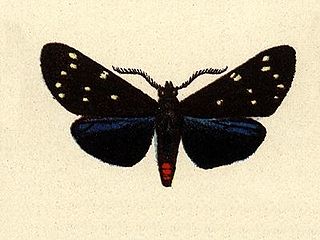
The Eton Choirbook is a richly illuminated manuscript collection of English sacred music composed during the late 15th century. It was one of very few collections of Latin liturgical music to survive the Reformation, and hence is an important source. It originally contained music by 24 different composers; however, many of the pieces are damaged or incomplete. It is one of three large choirbooks surviving from early-Tudor England.

Copadichromis is a genus of haplochromine cichlids endemic to Lake Malawi in Eastern Africa. Copadichromis are part of a group known as utaka and are popular with aquarists, as this genus is relatively peaceful in captivity compared to the mbuna.
Heliconia virginalis is a species of plant in the family Heliconiaceae. It is endemic to Ecuador.

Eubranchidae is a taxonomic family of sea slugs, marine gastropod molluscs in the superfamily Aeolidioidea, the aeolid nudibranchs.

Ctenuchidia is a genus of moths in the subfamily Arctiinae. The genus was erected by Augustus Radcliffe Grote in 1866.

The marbled crayfish or Marmorkrebs is a parthenogenetic crayfish that was discovered in the pet trade in Germany in 1995. Marbled crayfish are closely related to the "slough crayfish", Procambarus fallax, which is widely distributed across Florida. No natural populations of marbled crayfish are known. Information provided by one of the original pet traders as to where the marbled crayfish originated was deemed "totally confusing and unreliable". The informal name Marmorkrebs is German for "marbled crayfish".

Isabelia is an orchid genus formed by three tiny species and one natural hybrid, spread from the Northeast of Brazil to Argentina, which are closely related to the genus Constantia. During more than a century Isabelia was a genus formed by just one species, however, around 1968, it was merged with genus Neolauchea, also unispecific. In 2001, a third genus was added to it, Sophronitella. The genus name is abbreviated Isa. in cultivation.

Eubranchus is a genus of aeolid nudibranch in the family Eubranchidae.

Brenthia is a genus of moths in the family Choreutidae.

Ctenuchidia virgo is a moth of the subfamily Arctiinae first described by Gottlieb August Wilhelm Herrich-Schäffer in 1855. It is found on Jamaica, Cuba and Puerto Rico.
Hugh Kellyk (fl.c.1480) was an English composer, whose two surviving works are preserved in the Eton Choirbook. These two works are a five-part Magnificat and a seven-part Gaude flore virginali, which appear to be among the earlier pieces in the choirbook. Gaude Flore Virginali was recorded by The Sixteen in 1994, the Magnificat by Tonus Peregrinus.
Somatina virginalis is a moth of the family Geometridae. It is found in Angola, the Democratic Republic of Congo, Kenya, Malawi, Sierra Leone, South Africa, Tanzania, Uganda and Zimbabwe.

The Pericopina is a subtribe of tiger moths in the family Erebidae. The subtribe was described by Francis Walker in 1869.
Ctenuchidia agrius is a moth of the subfamily Arctiinae. It was described by Johan Christian Fabricius in 1781. It is found in Suriname.
Ctenuchidia fulvibasis is a moth of the subfamily Arctiinae. It was described by Hering in 1925. It is found on Jamaica.
Ctenuchidia gundlachia is a moth of the subfamily Arctiinae. It was described by William Schaus in 1904. It is found on Cuba.
Ctenuchidia interrupta is a moth of the subfamily Arctiinae. It was described by Hering in 1925. It is found on Dominica.
Ctenuchidia subcyanea is a moth of the subfamily Arctiinae. It was described by Francis Walker in 1854. It is found on Hispaniola.

Protitame virginalis, the virgin moth, is a moth in the family Geometridae. The species was first described by George Duryea Hulst in 1900. It is found in North America.








